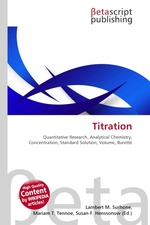Titration
Lambert M. Surhone, Miriam T. Timpledon, Susan F. Marseken
бумажная книга
High Quality Content by WIKIPEDIA articles! Titration setup: the titrant drops from the burette into the analyte solution in the flask. An indicator present then changes color permanently at the endpoint. Titration is a common laboratory method of quantitative chemical analysis that is used to determine the unknown concentration of a known reactant. Because volume measurements play a key role in titration, it is also known as volumetric analysis. A reagent, called the titrant or titrator, of a known concentration (a standard solution) and volume is used to react with a solution of the analyte or titrand, whose concentration is not known. Using a calibrated burette to add the titrant, it is possible to determine the exact amount that has been consumed when the endpoint is reached.
Данное издание не является оригинальным. Книга печатается по технологии принт-он-деманд после получения заказа.


